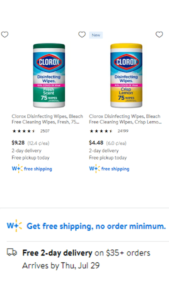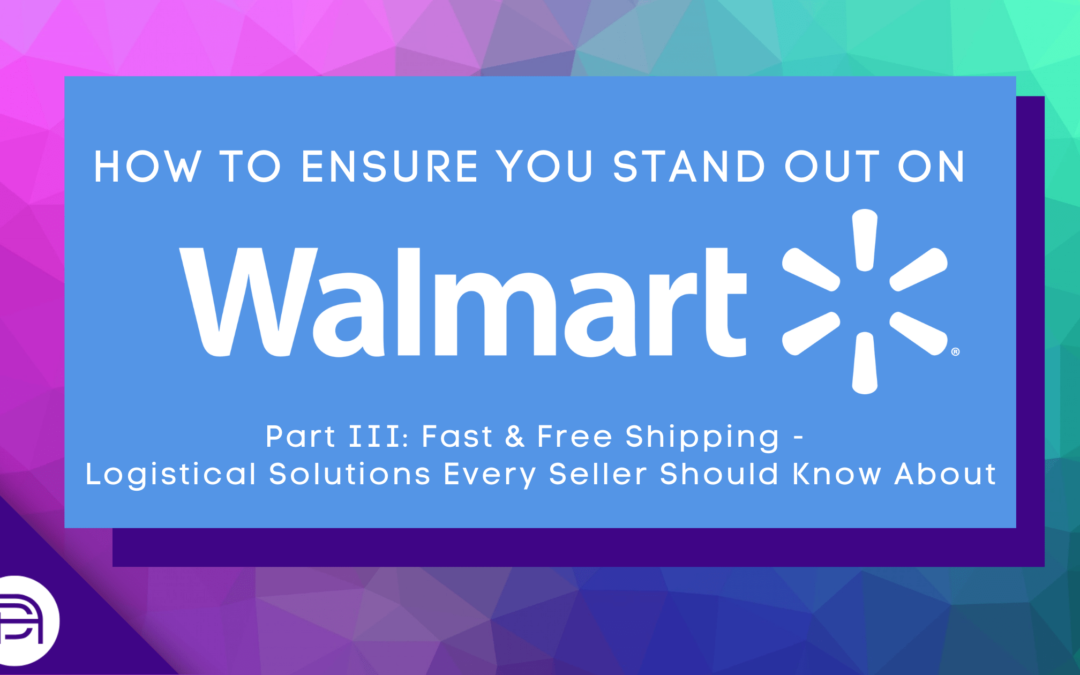Throughout our three-part Walmart Growth Series, we have covered how to set up your product pages for success (here) as well as how to stand out and drive conversions on Walmart (here).
In our final Walmart blog post, we will review various seller shipping options and the best strategies for fulfilling your orders.
Shipping Options
Walmart offers a number of shipping options for sellers, segmented by delivery time and cost:
-
-
- Free Value
- Standard
- Three-Day
- Two-Day
- Next Day
- Freight
-
By default, free value shipping will be enabled when you start selling on Walmart. Customers will get free shipping with this option while the seller can choose the least expensive (and often slowest) fulfillment choice to ship orders.
As a seller, the greatest benefits of free value shipping are the low cost of shipping products and delivery lead times. Sellers have a maximum of 1 day to get the product prepped for shipping and the estimated transit time is 3-7 days, meaning consumers won’t receive the product(s) for up to 9 business days after placing an order. The obvious downside to free value delivery is longer delivery times. As consumers continue to expect fast and free shipping, you may end up losing sales when someone needs their favorite coffee in two days versus nine.
Note that while you cannot disable value shipping in Walmart Seller Central, you can override the feature by manually choosing individual items to be excluded from free value shipping.
The next option you can opt into as a seller is standard shipping. With standard shipping, you are allowed a transit time of 3-5 days and can recommend tiered shipping prices based on a product’s overall cost. The product should arrive in 4-7 days depending on what transit times you set up.
Remember that the consumer can still select free shipping through the always enabled free value option, but faster delivery is available with standard shipping if the consumer is willing to pay extra (unless you choose to extend free shipping with this choice).
The last shipping option we will cover is two-day shipping. Similar to how Amazon presents a Prime badge to sellers if they meet certain criteria, Walmart displays a free shipping badge on eligible products to drive buy box wins and conversions.
A Walmart badge signifies that a seller always has a free shipping choice for the consumer without requiring a W+ membership or the $35 minimum order. Products that meet eligibility requirements will receive a two-day delivery badge as well.
You can only apply for this program if you have been a marketplace seller for more than 90 days OR have already fulfilled a minimum of 20 orders within the last 30 days that meet the criteria below:
-
-
- On-Time Shipping: >95%
- On-Time Delivery: >95%
- Valid Tracking Rate: >95%
- Cancellation Rate: <1.5%
-
The two-day delivery program is available if you choose to self-fulfill products directly from your warehouse or leverage a third-party partner, which leads us to the next section of this article: How to fulfill orders.
Fulfillment Options:
The least expensive fulfillment method is to package and send products yourself.
However, this is not necessarily always the best choice.
When you fulfill products yourself, you need to ensure that you have the proper systems in place along with a team to package products, ship orders, and handle returns. Additionally, this method can hurt your traffic and conversions since you lose out on immediate access to key shipping programs.
Below are two alternatives that can boost your fulfillment efficiency and drive additional sales on Walmart:
1. Deliverr is a third-party fulfillment provider that Walmart has partnered with. Working with Deliverr is a fast and easy way for sellers to secure and maintain access to the two-day delivery program. Unlike Walmart Seller Central, there is no grace period or minimum requirement for two-day shipping when using Deliverr.
You can choose to use Deliverr for standard (5-7 days), three-day, and two-day delivery.
Deliverr pricing is broken down by fulfillment costs and storage costs:
-
-
- Fulfillment Cost: Starts at $3.99 per unit, but varies depending on weight, dimensions, and service level. This includes receiving, shipping, order handling, and package costs.
- Storage Cost: Starts at $0.75/cubic foot per month. This is the standard cost between January and September, but pricing rises to $2.40 October through December. In addition, Deliverr will begin imposing long-term storage fees if the product is at a warehouse for more than 365 days. Long-term storage fees can cost around $6.90 per cubic foot per month for each unit.
-
2. Walmart Fulfillment Service (WFS) is a relatively new service that Walmart began providing in 2020. Similar to FBA (Fulfilment by Amazon), WFS is a service that allows sellers to ship goods directly to a Walmart Fulfillment Center and let Walmart handle the rest.
WFS streamlines the seller-side process and gives product pages enrolled in the program a Walmart+ badge. W+ is a program much like Amazon’s Prime Membership, giving members access to premium shipping for a yearly fee. Products in W+ grant consumers not enrolled in the program free shipping on orders $35+. WFS also provides a two-day delivery service to consumers. According to Walmart, the program boosts items on the search results page by providing badges.

Walmart sellers who have enrolled in the WFS program and already had a two-day shipping option have seen an average sales lift of 20% while sellers who did not have two-day shipping beforehand are seeing a 65% sales increase on average after enrollment.
While costs of WFS are generally lower than Deliverr fees, it is important to note that sellers must apply and get approval to be part of WFS. Additionally, the service is only available to sellers with a physical warehouse in the United States.
WFS pricing is broken down by fulfillment costs and storage costs:
-
-
- Fulfillment Cost: Fee-based on an item’s shipping or dimensional weight starting at $3.45 for items less than or equal to a pound with tiered pricing based on weight.
- Storage Cost: $0.75/cubic foot per month from January through September. Pricing increases to $1.50/cubic foot from October through December. Long-term storage fees are applied when inventory is in a Walmart FC for more than 365 days at $7.50/cubic foot per month.
-
Whether you are a seasoned seller or looking to launch on Walmart, there are many important areas to consider that will directly impact sales, traffic, conversions, and operational costs. Direct Agents helps sellers navigate all areas of the Walmart Marketplace and can guide you through choosing the right option for your business. We have worked with various sellers to update their shipping profiles and convert items to WFS.
In need of an incredible team of Walmart experts who will guide you toward Walmart Marketplace success? Reach out to us at [email protected] today to chat. We love sharing our expertise and making connections with new brands!
– Emily Lease (Senior eCommerce Strategist)



